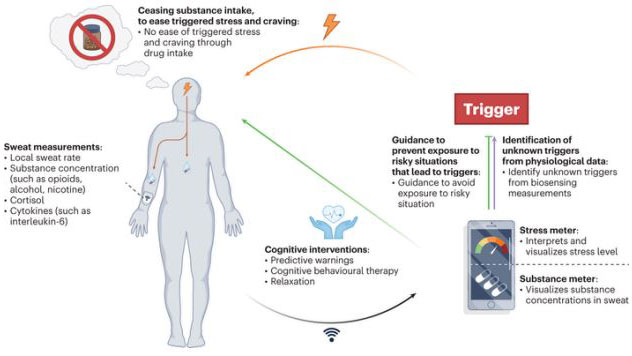Towards on-skin analysis of sweat for managing disorders of substance abuse
Non-invasive sweat analysis with state-of-the-art sensor technology - patient-centered and thus the basis of a precise treatment strategy. We congratulate Dr. med Noé Brasier, MedLab Fellow, on the recent publication of his Comment paper on this innovative health topic in Nature Biomedical Engineering.

The increase in substance abuse disorders is a growing health problem worldwide. Since increased perspiration is a typical physiological response during craving, it is in principle a valuable biomarker.
Early-Career Fellow Noé Brasier, MD, and contributing authors of this latest concept paper argue that a personalized digital biomarker signature driven by a machine learning model could further support the care and treatment of patients with SUDs.
Wearable sensors
Wearable sweat sensors enable simple and continuous measurement of sweat levels, and thus non-invasive therapeutic drug monitoring for opioids and other substances. To this end, the present authors describe the translational development - from research into the relevant physiology and technological requirements to clinical implementation - of such a sweat-based, patient-centered sensor system. A skin patch for example, that can monitor sweat rate and the concentration of drugs and their metabolites locally and send the information to a connected device would enable real-time data analysis and evaluation.
Patient-centered healthcare
In Health 4.0, the role of the patient is changing to that of an enabled citizen. Collected health data is now continuously accessible in various ways. The patient is provided with more insight in his health data and a greater share in the treatment method.
Patient care becomes more precise. A wearable sensor for use in the context of SUDs would ideally exist for the detection of multiple biomarkers with personalized calibration. Such a wearable sensor would be integrated with sensors for simultaneous monitoring of heart rate, blood pressure and skin conductance and coupled with machine learning models for accurate data analysis. Currently, there are no devices for research that meet all these criteria. Moreover, the development and validation of digital biomarkers faces regulatory challenges that need to be addressed.
Read the full article external pagehere
Towards on-skin analysis of sweat for managing disorders of substance abuse.
Noe Brasier, Juliane R. Sempionatto, Steven Bourke, George Havenith, Dietmar Schaffarczyk, Jörg Goldhahn, Christian Lüscher & Wei Gao. Nature Biomdedical Engineering (https://www.nature.com/articles/s41551-024-01187-6)
